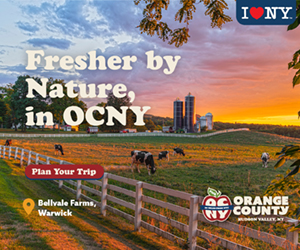The Hudson Valley’s beautiful river, shorelines, and mountains have led some to call the Valley, “America’s Rhineland.” Portions of the Valley have similar geological rock formations of shale, slate, and schist under well-drained clay soils that are similar to those found in the wine producing areas of the Rhine Valley. In those regions, the dry and dessert wines produced by the noble Riesling grape reign supreme, so it only makes sense that more Riesling should be planted here in the Hudson Valley.
Riesling, also known as Johannisberg Riesling or White Riesling, originated—or was at least first identified—in Germany as early as the tenth century and definitely by the fifteenth century. Riesling is a white vinifera grape that was identified by local growers, propagated, and then distributed to other local growers. Like Chardonnay, it is adaptable to many different types of soils, but unlike Chardonnay, it tends to retain its floral wine flavors and structure when it is grown in cool climate areas such as Germany, the Hudson Valley, or the Finger Lakes.
Riesling is a moderately vigorous growing variety whose yield is more dependent on growing conditions than most other grape varieties. Its bud break is late, so spring frost damage is rare. Riesling’s cylindrical, conical, and compact clusters are small to medium-small in size, with small round berries. The berries can be clear green to golden yellow in color.
There are several scores of Riesling clones or sibling plants that are being used to produce wine in Germany and the Finger Lakes—regions that specialize in growing Riesling. Many of these Riesling clones have not been systematically tested in the Hudson Valley, but those grown here include Clones 90, 198, 239 and 356. Each of these clones offers the winemaker a different bouquet and flavor profile, balance and structure, and each grows differently in the field.
Rieslings can be made into dry, semi-dry, sweet, and very sweet dessert wines. Unlike many other wine grapes, Riesling develops its fruity aromas at relative low sugar levels of 17 brix. So if a lean Riesling is desired, the variety can be picked with lower sugars as early as late September or early October to produce a dry, austere wine. For the grower, this is important because if the season is late due to cold or rain, Riesling can be picked at 17 to 19 brix and still be made into a quality wine that has varietal flavors. Due to its high acidity and possible low sugar content, Riesling can also be successfully made into sparkling wines.
No matter what type of Riesling is made, it tends to be a distinctly varietal wine that is aromatic, forward, fruity, spicy, and very flowery. Hence, it lends itself to stainless and glass aging, and not wood aging. However, some wine makers have aged the wine in lighter woods, such as beech wood, with positive results. Overall, it is not as versatile as the Chardonnay or Seyval Blanc grape in the cellar. However, Riesling does have a cost advantage over Chardonnay in its production. This is because Riesling does not need wood aging nor malolactic fermentation and thus can be ready for market by the May following its harvest.
In dry and semi-dry Riesling wines, its crisp high acid is balanced by big, forward, floral fragrant smells and flavors of white peaches, citrus, pineapples, green apples, lime/lime peel, melons, and dried flowers with hints of honey, spice, and herbs, with a clean finish and minerally aftertaste. The substantial body of these wines is minerally, like flint, with herbal tastes of pine resin or juniper berries similar to that found in gin that has a greasy taste. With all that said, Riesling has a solid palate weight to balance all of that fruit and acid.
Sweet or dessert Rieslings and ice wines are produced by letting the grapes hang on the vine until the fourth week of October, or later. As the grapes hang on the vine, they get continually sweeter, as the water evaporates and the berries become more like raisins. In select years, ice wines can also be made. The grapes are harvested while frozen and pressed so that only the sweetest juice is extracted, as the water in the berries is frozen. For ice wines, having brix levels of 50 are not uncommon.
Common descriptors for sweet Rieslings are that they have very big aromatic flavors of ripe apricots, peaches and pineapples, honey, oranges, and orange rinds (similar to that found in the liquor Grand Marnier). This opulent fruit flavor is balanced by the heavy, rich viscosity of the wine and its unnoticed high acid due to its high sugar content. As Rieslings get sweeter and more viscous, the flinty/minerally body and taste tends to diminish and is replaced by the acids and tastes found in raw honey. Similar flavors can be had with dessert and ice wines made from Vignoles, and sometimes Vidal.
Rieslings made in the Hudson Valley are quality wines that can be widely obtained at affordable prices. Most wineries offer at least one wine made from Riesling, be it a dry, semi-dry or dessert wine style.





